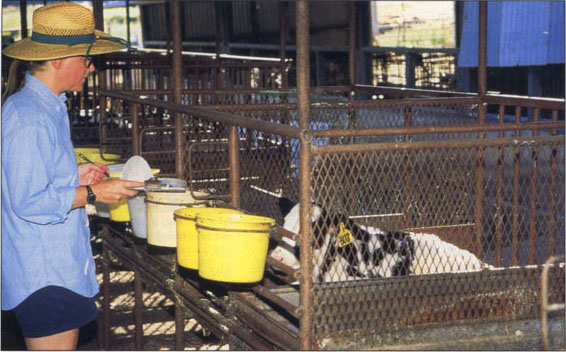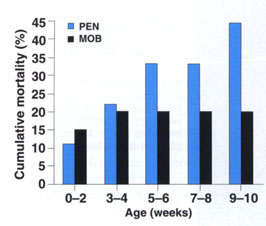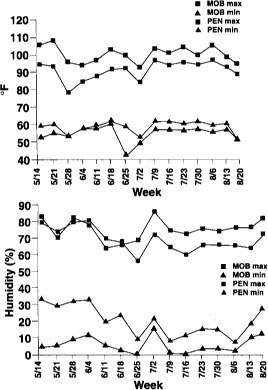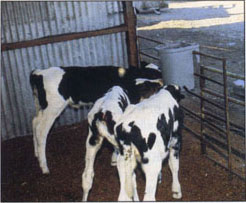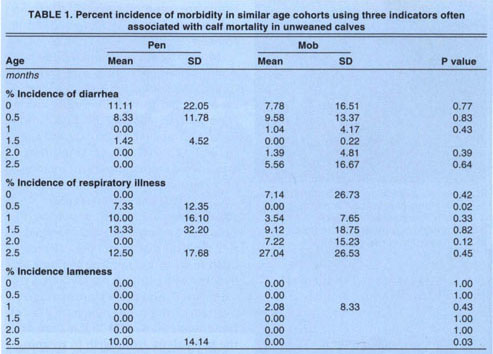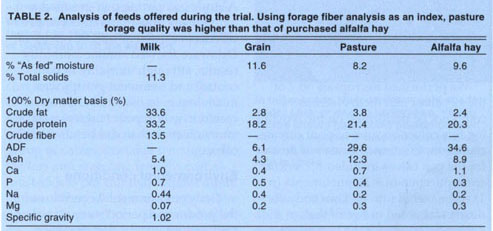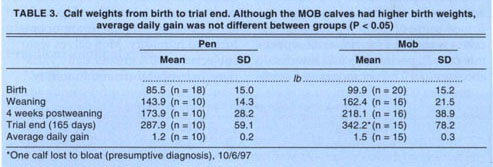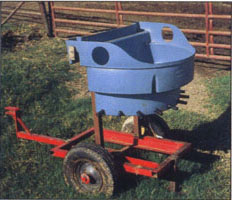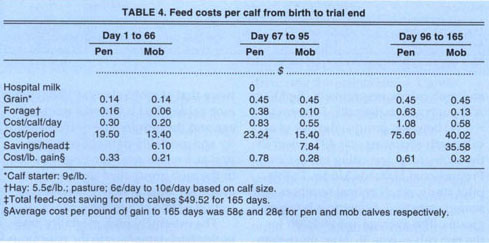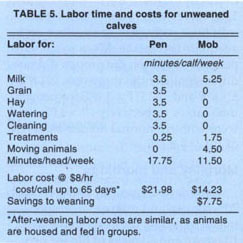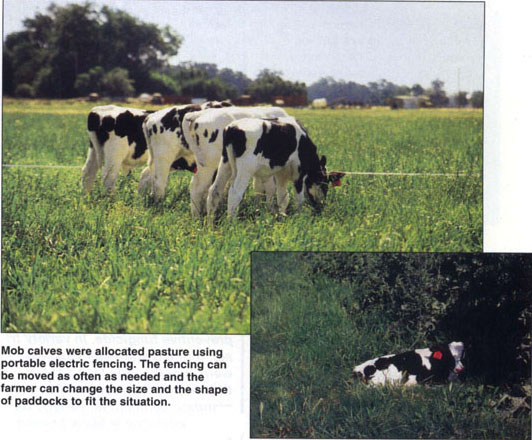All Issues
Rearing immunodeficient calves on pasture reduces death, production costs
Publication Information
California Agriculture 53(6):35-40. https://doi.org/10.3733/ca.v053n06p35
Published November 01, 1999
PDF | Citation | Permissions
Summary
The risk of death was 40% less and feed costs were 48% lower for calves mob- reared on pasture than for calves reared in individual pens.
Full text
Near left, calves were observed three times each week during the trial and any signs of illness or injury were recorded.Far left, calves were weighed on a portable livestock scale at birth, weaning, 1 month post- weaning and at the con- clusion of the trial.
Neonatal calves rely on passive immune function from the ingestion of colostrum to maintain health, because the calf's own immune system is not fully functional until the age of 6 to 8 weeks. Blood serum immunoglobulin G (IgG) levels are an indicator of adequate ingestion of high quality colostrum. According to a 1992 analysis of heifer-calf IgG by the National Animal Health Monitoring Systems, approximately 40% of U.S. dairy heifer calves are colostrum deprived, and 25% of those are severely deficient in IgG. Adequate colostrum delivery is the best prevention against neonatal calf disease. Diseases in early life may affect future productive ability and longevity of the adult in the herd, causing economic impact to the dairy beyond production costs of the heifer calf.
California's dairies are growing larger every year, with farms averaging more than 600 cows per herd in 1997. Specialization in tasks performed on the dairy occurs along with this expansion. Calf rearing is a separate enterprise from the milk harvesting operation, and may be contracted out to professional heifer growers. Traditionally, newborn calves are reared in individual pens, with limited calf-to-calf contact, in an effort to reduce disease. Calves are not placed into groups until after weaning at 8 weeks of age. This rearing method is labor and capital intensive.
In some parts of the world, rearing young calves on pasture is the norm. New Zealand uses such a system. There, calves are placed in small groups when born and nurse from a multiple-teat feeder. The calves are moved to pasture when they are a few days old and progressively merge with other, similar age groups of calves as they grow. Calves are offered shelter from inclement weather, but no effort is made to isolate them from one another. Dairy producers and professional heifer growers in northern and coastal California have grass-based resources that can support this type of program.
This on-farm pilot study compared two rearing systems: calves mob reared on pasture and calves individually housed in elevated metal pens. Both groups were deficient in passive immune transfer, as evidenced by low IgG levels. The objectives of this study were to compare the effects of the two rearing systems on growth, morbidity, mortality and production costs in immunodeficient dairy calves.
Pasture versus pen
The field study took place on a 300-cow dairy in the Sacramento Valley between April and October of 1997. In the spring, 38 colostrum-deprived Holstein calves were randomly assigned at birth (by gender) to one of two rearing treatments. We compared 18 calves reared in individual elevated metal pens (8 feet by 6 feet) to 20 calves mob-reared on pasture at a stocking rate of approximately 20 calves per acre. The “pen” calves, although housed individually, were not restrained within the unbedded pens and could contact calves in adjacent pens. The pen floor was 3 feet above the ground, for ease of waste removal. Although outdoors, the pen rows were covered with a continuous metal roof. The pens had been empty for more than a year prior to the start of the trial.
Fig. 2. Mean weekly maximum and minimum environmental temperature and humidity for mob calves on pasture and for pen calves.
According to normal management protocol for this farm, calves were fed milk withheld from the bulk tank due to antibiotic holding times (hospital milk), grain and forages up to weaning at 65 days of age, when milk was no longer offered. We evaluated the health and growth of individual calves within each group from birth to 4 weeks past weaning (approximately 94 days of age). Growth rate and feed costs were studied for an additional 70 days. Within each group, environmental conditions were recorded from the time the first calf was enrolled until all calves were weaned.
At enrollment, we weighed the calves on a portable livestock scale, recorded rectal temperature and morbidity observations, and collected venous blood samples. Pen calves were placed in metal pens when enrolled. “Mob” calves were temporarily housed as a group for several feedings — while they learned to suckle the milk feeder — then were moved to pasture, usually at 3 or 4 days of age. The mob calves were temporarily housed in a large wooden shed (15 feet by 24 feet with a metal roof and a dirt floor covered with crushed almond shells).
The occurrence of diarrhea (loose stool, not ranked or scored), respiratory illness (increased respiration rate, coughing, panting), nasal or ocular discharge (visible mucus, tearing of eyes), refused or unfinished milk (observed not eating or feed remaining; refused feed was not measured), lameness (abnormal gait or favoring a limb or hoof), injury (laceration or other external wound), and calves' inability to stand due to illness were recorded 3 times per week throughout the study period. In addition to the 3-times-weekly observations, we collected rectal temperature and an additional set of morbidity observations biweekly until weaning. Individual calf weights were recorded again at weaning, at 28 days postweaning and at 165 days after the start of the trial. Two technicians shared responsibility for recording observations in both animal groups and were instructed in standardizing the observations. Calves that died were submitted to the California Veterinary Diagnostic Laboratory at UC Davis for necropsy.
Climatic temperature and relative humidity were monitored continually until all calves were weaned, using a 7-day tracing unit placed at each site. We determined maximum and minimum temperature and humidity from continuous 24-hour tracings.
Feeding and management
Pen calves received chopped alfalfa hay, while mob calves grazed irrigated perennial pastures composed of ladino clover, annual and perennial ryegrass, tall fescue, native bromegrass and bermudagrass. Both pen and mob calves were allocated a half-gallon of hospital milk per head, twice daily until weaning. Water, grain and forage were offered ad libitum. Pen calves received individual feedings in buckets. Mob calves, as a group, received grain and milk in pasture feeders. Because variation in feeding behavior (aggression, intake) within the mob treatment was anticipated, we minimized intake differences, grouping calves by size and appetite.
Calves were weaned based on body condition and when consuming approximately 2 pounds of grain per day. At weaning, mob calves were moved into a weaned group (also on pasture). Pen calves were moved to a dry lot (dirt pen) and fed in similar age groups. Once weaned, grain was increased to a limit of 5 lb/head/day for both groups. Maximum hay consumption for weaned pen calves was limited to 7 lb/head/day. Mob calves received ad-libitum access to pasture.
Paddocks were fenced with a combination of permanent fencing and portable electric fencing. A portable water tank was provided for mob calves because they did not have access to larger permanent stock tanks. We calculated purchased feed and pasture production costs. Animals in both groups received medical treatments according to standard farm protocol. If necessary, farm personnel isolated calves for treatment, then returned them to their group following recovery. Antibiotic treatment costs were recorded.
Blood analysis
Radial immunodiffusion techniques quantified serum IgG concentrations from blood collected within 5 days of birth. Transfer of passive immunity was classified by IgG concentration. Less than 1,600 mg/dl was considered inadequate passive immune transfer.
Calves need some training to use the feeding equipment. After a few days in groups of two or three, calves can be moved into groups of 10 or more, depending on the capacity of the equipment and calf feeding behavior. Groups should be matched for size and appetite.
Statistical analysis
Temperature was analyzed using factorial ANOVA (GLM). Morbidity data was analyzed using the nonpara-metric Mann-Whitney tests (NPARIWAY). Mortality data was analyzed using the Cox Proportional Hazards Model (PHREG).
Passive immune transfer
When calves are properly fed high quality colostrum, normal IgG levels should be above 1,600 milligrams per deciliter (mg/dL). The mean serum IgG levels for the pen and mob calves were 867.9 ± 143.4 mg/dL and 859.3 ± 132.1 mg/dL respectively, and did not differ significantly (P > 0.05). Thus the trial was performed on a majority of calves that had not ingested or had failed to absorb sufficient quantities of immunoglobulins from colostrum and were similar to severely colostrum-deprived calves in the NAHMS study. Trial calves were more susceptible to infectious pathogens than calves with adequate IgG intake. Mean rectal temperatures between the groups did not differ significantly; they were 101.8°F ± 1.0°F and 102.1°F ± 1.0°F for pen and mob calves respectively (P > 0.05), and were within a normal nonfebrile range of 101.5°F ± 1.°F.
Mortality and morbidity
Cumulative mortality was 44% and 20% for pen and mob calves respectively. Mortality occurred in the first 10 weeks and 4 weeks of life for pen and mob calves, respectively (fig. 1). Although not statistically different (P = 0.14) between groups, the risk of a calf death occurring was 40% lower in the mob group according to the Cox Proportional Hazards Model. In this pilot study small animal numbers obscured statistical differences between groups. The average age at death for the pen calves was 36 days, more than twice that of mob calves at 15 days. No mob calves died between 4 weeks of age and the termination of the morbidity and mortality data collection period at 4 weeks postweaning. One calf in the mob group died (presumptive diagnosis: bloat) outside the data collection period at 5 months of age.
TABLE 1 Percent incidence of morbidity in similar age cohorts using three indicators often associated with calf mortality in unweaned calves
TABLE 2 Analysis of feeds offered during the trial. Using forage fiber analysis as an index, pasture forage quality was higher than that of purchased alfalfa hay
TABLE 3 Calf weights from birth to trial end. Although the MOB calves had higher birth weights, average daily gain was not different between groups (P < 0.05)
The extremely high mortality rates in this trial demonstrate the enormous risk that calves face when there is failure of passive immune transfer. Unfortunately, a large percentage of dairy farms have inadequate colostrum delivery programs, and average U.S. dairy heifer calf mortality rates are close to 9%, according to NAHMS data. Most well-managed commercial dairy calf-raising operations limit mortality rates to less than 5%.
This portable feeder can accommodate 10 calves and can be easily towed by a 4-wheel all-terrain vehicle (ATV). Any other needed supplies can be taken out to the paddock in the same trip.
We performed necropsies on 7 of the 12 calves that died. Necropsies could not be performed on the remaining five calves because of poor carcass condition. Confirmed causes of death for the pen calves included Escherichia coli septicemia (n = 2), pneumonia (n = 1) and navel ill (n = 1). Thin body condition was noted in two of the necropsy reports for the pen calves and none for the mob calves. Confirmed cause of death for the mob calves included Escherichia coli septicemia (n = 2), pericarditis and intestinal abcesses (n = 1). Pneumonia and septicemia are common causes of death for calves with failure of passive immune transfer.
Morbidity was evaluated by percent incidence of diarrhea, respiratory illness, lameness, injury and ocular/nasal discharge in similar-age cohorts from birth to weaning (65 days), and for the groups without regard to age (table 1). The only significant differences were a greater percent incidence of respiratory illness (0.5 months of age; P = 0.02) and lameness (2.5 months of age; P = 0.03) in pen calves. Both pen and mob groups averaged five medical treatments per calf from birth to weaning. Because the type and expense of treatment depended on the drugs used, and costs were averaged over surviving calves, the mob per-calf treatment cost was $0.25 less than for the pen calves, from birth to weaning. A study comparing pen-grouped and individually housed immune-competent calves conducted at the University of Delaware showed similar morbidity results, although mortality in both control and treatment groups was much lower. In that study, calves reared in group pens had fewer days on medication than did hutch-reared calves.
Environmental conditions
Daily environmental conditions for the production period were significantly different (P < 0.05) between pasture and pen locations. Figure 2 shows weekly averages for temperature and humidity. Mob calves were subjected to 30% greater daily variations in temperature and humidity during the production period. Greater daily environmental variation for mob calves on pasture could precipitate a greater incidence of disease, but no such effect was seen in this trial. Transient morbidity differences between mob and pen calves were observed for certain age groups, but not between the groups over the entire trial (P > 0.05).
Mob calves had some natural shelter from trees and hedgerows, but no permanent housing. Because this trial was conducted during the late spring and summer months, shades or other shelter were not provided. Early in the trial, mob calves were given temporary shelter in the enrollment shed during rain. If calves are to be pastured on a regular basis during wet, cold weather, shelter should be provided. These costs would be added to capital expense. The ability of young calves to maintain body temperature is crucial for health, and calves need to remain dry to maintain normal body temperature.
Nutrition and daily gain
The nutrient analysis of the mob forages showed a lower acid-detergent fiber level and slightly higher protein and fat than pen forage (alfalfa hay) (table 2). Lower acid-detergent fiber levels indicate higher digestibility of forage. Calves were weaned based on body condition and feed consumption. Average age at weaning was 65 days for pen calves and 67 days for mob calves. table 3 shows calf body weight during the trial. Average daily gains from birth to weaning were 0.94 ± 0.34 lb/day and 0.95 ± .36 lb/day for pen and mob calves respectively, and were not significantly different (P > 0.05). We calculated cost per pound of gain by dividing total feed costs by total weight gain for the period. Although weight gains were comparable for both groups of unweaned calves, at $0.21/lb of gain versus $0.33/lb of gain, mob calves had 36% lower feed costs per pound of gain than pen calves. Cost savings were due to the lower cost of forages (table 4).
Average daily gain for the 28 days following weaning was greater (P < 0.05) for mob calves at 2.0 ± 0.8 lb/day compared to 1.1 ± 0.7 lb/day for pen calves. Forage quality and ad-libitum rate of intake were factors contributing to gain. Limiting intake of purchased forages for pen calves did not result in savings when compared to pasture production costs. Mob feed costs per pound of gain were 64% lower than pen costs during this period ($0.28/lb of gain versus $0.78/lb of gain for mob and pen calves respectively). Average daily gain for the period from 1 month postweaning to approximately 165 days of age was not significantly different (P > 0.05), with a gain of 1.6 ± 0.6 lb/day and 1.8 ± 0.4 lb/day for pen and mob calves respectively. Mob feed costs per pound of gain were 47% lower than pen costs during this period ($0.32/lb of gain versus $0.61 cents/lb of gain for pen and mob calves respectively). Mob pasture production costs were $36/ton, compared to pen alfalfa hay costs of $110/ton plus the added labor and equipment needed to chop it. Over the entire trial (165 days), cost/lb of gain averaged $0.28 for the mob calves compared to $0.58 for the pen calves. The average daily gain was 1.2 ± 0.2 lb/day and 1.5 ± 0.3 lb/day for the pen and mob calves respectively (P < 0.05).
Labor and equipment
Nearly $8 in labor was saved per mob calf from birth to weaning (table 5). Because mob calves are handled as a group, labor inputs are similar whether there are 5 or 25 calves. In the Delaware study, labor per calf per day for group-pen calves was one-tenth of that for the hutch-reared calves. This cost saving allowed for the purchase of computerized feeding equipment for pen-grouped calves. When mob capital inputs are cost averaged over a group of calves, portable fencing, milk feeders and watering troughs cost almost $5 less per calf than capital input of pen calves, which includes portable hutches, livestock paneling and buckets. After weaning, costs were similar because weaned pen calves were placed in groups in dry-lot pens.
Mob calves were allocated pasture using portable electric fencing. The fencing can be moved as often as needed and the farmer can change the size and the shape of paddocks to fit the situation.
Practical implications
Newborn immunodeficient calves can be successfully mob reared on pasture without increasing their risk of morbidity or mortality compared to calves reared in individual pens. However, some provision should be made for sheltering calves in wet weather. Using the mortality risk and death loss in this trial, and a calf value of $1 per pound of live weight, reduced death losses would save the producer in this pilot study (rearing 200 calves a year on pasture) more than $7,000. Even considering the expense of sheltering calves, the benefits of reduced mortality risk can easily offset building and material costs.
For producers with pasture available, mob rearing has potential to become a part of California's dairy calfrearing program, and significant savings can be realized because of lower feed, labor and equipment costs. In this trial, $63 per calf was saved in labor, housing and feed. That translates into savings of $12,500 per year for 200 calves. Mob rearing should not be a substitute for good management, but it could be used in conjunction with high-quality colostrum feeding, excellent sanitation and frequent calf observation.
Beyond cost savings, environmental regulations are putting pressure on dairies to reduce animal numbers and manure loading rates. Moving heifer production out of confinement and into extensive production systems may increase the use of this type of rearing system and improve animal waste loads on dairies.
As a preliminary demonstration project, funding limited the scope of variables that could be measured and reported here. Continued research of this type on a larger scale will help further define the potential benefits of a mob-rearing system and should include additional stress and infection measurements, such as white blood cell counts, neutrophil: lymphocyte ratios, and acute phase proteins.



